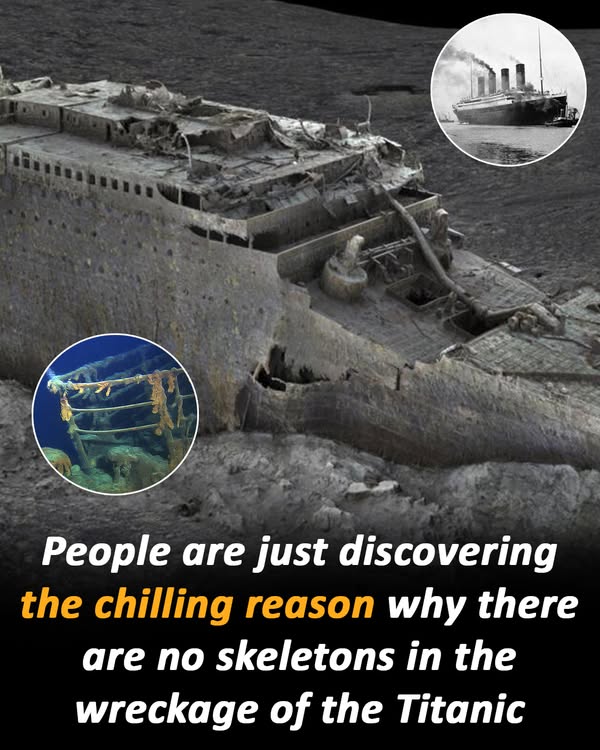The tragic sinking of the RMS Titanic on April 15, 1912, remains one of the most haunting maritime disasters in history. Over a century later, the world is still captivated by the events of that fateful night when the so-called “unsinkable” ship collided with an iceberg during its maiden voyage from Southampton to New York. More than 1,500 people lost their lives in the disaster, making it one of the deadliest peacetime sinkings of a passenger ship. Yet, among the many lingering questions surrounding the Titanic, one mystery continues to perplex researchers and historians alike: why were so few bodies ever recovered?

The wreckage of the Titanic wasn’t discovered until September 1, 1985, lying more than 12,000 feet below the surface of the North Atlantic Ocean. For decades, countless expeditions and theories attempted to locate the ship, but it wasn’t until oceanographer Robert Ballard employed a new method—following the trail of debris—that the Titanic was finally found. Ballard, who had previously used this technique to locate the sunken nuclear submarine Scorpion, was able to trace the scattered debris across the ocean floor until he came upon the ship’s final resting place about 400 miles off the coast of Newfoundland, Canada.
Seeing the Titanic’s remains for the first time was a somber experience. Ballard has recounted how he and his team made a solemn vow not to remove anything from the wreck, to treat the site with the utmost respect as a gravesite for those who perished. Despite this commitment, expeditions in the years since have retrieved hundreds of artifacts, including furniture, silverware, luggage, and even unopened bottles of wine—everyday objects frozen in time. However, the first major recovery mission in 1987 revealed how deteriorated many items had become after decades in the harsh underwater environment.
What truly shocked researchers and the public alike was what wasn’t found: human remains. Though more than 1,500 people are believed to have died in the sinking, only 337 bodies were ever officially recovered. Of those, 119 were buried at sea and the rest returned to Halifax, Nova Scotia. But when Ballard and others explored the wreck itself, they were surprised to find almost no trace of the victims. There were no skeletons, no bodies—only personal belongings scattered across the ocean floor, such as shoes, boots, and clothing. Filmmaker James Cameron, who has visited the Titanic wreck more than 30 times, told The New York Times in 2012 that he had never seen any human remains, though he had come across shoes arranged in a way that clearly suggested someone once lay there.
This absence has puzzled many, prompting questions about what really happened to all those who perished. The answer lies in the unique environment at such an extreme depth. At over 12,000 feet below sea level, the water temperature hovers just above freezing, and the pressure is immense. These conditions create a harsh setting for any organic material to survive. Marine life in the deep ocean, including bacteria and scavengers, rapidly consume soft tissues. Items like shoes remain because they are made from materials that marine organisms cannot digest.
But the disappearance of even bones adds another layer of complexity. Robert Ballard has explained that at such depths, the chemical composition of the seawater plays a crucial role. Below approximately 3,000 feet, the ocean passes the calcium carbonate compensation depth—a threshold beyond which the water becomes undersaturated with calcium carbonate, the essential component of bones. As a result, once soft tissues are eaten away, the bones themselves begin to dissolve. Ballard noted the difference between the Titanic’s location and that of wrecks in the Black Sea, where human remains have been preserved in near-mummified states due to the absence of marine life and the chemical makeup of the water.
In his interviews, Ballard has stressed that the dissolution of bones in the deep sea is a natural process. “At depth below about 3,000 feet,” he told NPR, “you pass below what’s called the calcium carbonate compensation depth. The water in the deep sea is under-saturated in calcium carbonate, which is mostly what bones are made of. So once the critters eat the flesh and expose the bones, the bones dissolve.” This explains why explorers have found clothing, shoes, and personal effects, but no human remains.
The eerie reality of the Titanic’s wreck site has fascinated and disturbed many. Images and descriptions of the debris field—which spans approximately five by three miles—often spark both wonder and sadness. For some, it’s chilling to imagine that the thousands who perished were simply absorbed by nature, leaving behind no trace. Others find solace in the idea that the ocean, in its own way, reclaimed the bodies and offered them a final resting place. As one online commenter put it, “The only comfort is that those victims were given back to nature the only way Mother Nature knows how.”
Since the wreck was found, numerous expeditions have returned to document and study it. Many of the recovered artifacts have been displayed in museums around the world, providing a glimpse into the lives of the passengers and crew. But the ship itself has not fared well. Over the years, it has suffered damage from submersibles, and a bacteria known as Halomonas titanicae has been eating away at the iron hull. Scientists estimate that the ship’s structure may collapse entirely within the next 50 years, turning it into little more than a rusted outline of what was once a grand ocean liner.
In 2023, the Titanic was back in the headlines for another tragic reason. A submersible named Titan, operated by OceanGate Expeditions to offer paying tourists a view of the famous wreck, imploded during a dive, killing all five people aboard. Among the dead were pilot Stockton Rush, co-founder of OceanGate; Titanic expert Paul-Henri Nargeolet; British billionaire Hamish Harding; and Pakistani businessman Shahzada Dawood and his 19-year-old son Suleman. This modern tragedy added another somber chapter to the already haunting legacy of the Titanic.
The mystery of the missing bodies continues to serve as a powerful reminder of nature’s immense forces and the profound loss that occurred that night. As time goes on, the Titanic’s story remains a symbol of human ambition, vulnerability, and the enduring mystery of the deep.





